
Timeline Of The Resurrection Revealed (Expanded Version)
A Compilation of Matthew, Mark, Luke and John
To be a Christian means to forgive the inexcusable because God has forgiven the inexcusable in you. — C. S. Lewis
Jesus was crucified on Friday, April 3rd 33 A.D. at approximately 9:00 a.m. (Mark 15:25). The term approximately is used as the ancients had no way to accurately tell time. They could only observe the sun’s position during the day and the phases of the moon at night. Nine o'clock was also the same time for the morning Temple sacrifice of a lamb.
Four days before the Passover Feast or Wednesday, all heads of households were required to select a Passover lamb. They were to inspect the lamb over fours days to see if it had any imperfections. Only then was it deemed acceptable in the eyes of God to consumed. The lamb was to be prepared without the breaking of any of its bones. Then it was to be roasted over a fire and eaten at sundown. Passover ceremonies in the Temple would occur the following day. The High Priest was required to personally select a Passover lamb to be sacrificed in the Temple plaza on behalf of himself and the nation of Judah.
Jesus entered Jerusalem on Sunday and over the next four days preached and was questioned or inspected by the Temple priesthood on behalf of Caiaphas in order to try and find fault or an imperfection in Him. It was on Wednesday or day four that the priests decided to stop asking Jesus questions. They stopped for two reasons. First, Jesus answered all their question accurately and with authority. Second, they stopped because they realized that Jesus was making them look foolish in the eyes of the public. As the priests walked away, Jesus prophesied that "after two days", or on Friday, He would be betrayed, crucified and then would come the feast of Passover on Saturday. At the exact same moment Jesus was prophesying these events, the High Priest Caiaphas was in his palace developing a plot to have Jesus killed while He was in Jerusalem for the Passover feast (Matthew 26:1-5). By engaging in this plot, Caiaphas was literally, figuratively and prophetically selecting Jesus to be his Passover sacrifice on behalf of the nation. Because Rome no longer allowed the Temple to execute people for blasphemy, the High Priest would personally convince Pilate to execute Jesus for the crime of sedition against Rome. His crucifixion would take place early Friday morning (Exodus 12:3,6; John 18:14, John 11:50). Jesus would be on the cross from approximately 9:00 a.m. until 3:00 p.m. This was also the exact same times as the morning and evening Temple sacrifices of a lamb.
At 3:00 p.m. Jesus prayed, “Father, into your hands I commit My Spirit.” Jesus had repeatedly stated that no man had the power to take his life (John 10:18). Therefore, Jesus had to command His Spirit to leave His body for Him to actually die (Luke 23:46). His Spirit obeyed His command and He instantly died. The centurion heard Jesus’ command, saw that He immediately died and was astounded to see a man command his own death. This event caused the centurion to say, “Truly he was the son of God” (Matthew 27:54; Luke 23:47). It was imperative that Jesus be the first of the three to die and here is why. No one ever died in the presence of Jesus. He was life incarnate and as such, death could not occur to anyone in His immediate vicinity. It was only after Jesus died that the two robbers would have been able to be killed.
The Feast of Passover would begin in three hours or 6:00 p.m. The Jewish day begins at 6:00 p.m. in accordance with the creation story, “And the evening and the morning was the first day.” (Genesis 1:5) Now that the Jewish authorities had witnessed Jesus’ death, they went to Pilate to request a favor. It was against Jewish law for a dead body to be left on public display after sundown if the following day was a feast day (Josephus, “War IV”, 317; Against Apion, 11.73). Therefore, they requested that the legs of the three crucified men be broken to speed up their deaths (Mark 15:29; John 19:31; Deuteronomy 21:22-23). Pilate agreed to their request and the soldiers broke the legs of the two robbers using a small sledgehammer (John 19:32). The two men would now no longer be able to raise themselves up by their legs in order to breathe and so quickly die of suffocation. But when the soldiers came to Jesus, they saw that He was already dead so they did not bother to break his legs (John 19:33). Not breaking His legs was in accordance with God's command that no bones of the Passover lamb were to be broken (Exodus 12:46).
God also instructed the Jews to put the blood of the lamb on the right and left door post sides, and on the top of the door frame using a hyssop branch. This sacrificial blood on the doorposts would cause the death angel or Satan, to pass over their homes that night and not kill their first-born (James Macknight, “A new literal translation from the original Greek of all the apostolical epistle” (London: Thomas Turnbull,1809), pg. 79.). This fallen angel was allowed to kill both the first-born male child in every Egyptian home and also every Egyptian first-born animal (Exodus 11:5). These first born children were allowed by God to be killed as revenge for the Egyptians killing the boy babies born to the Jews and sacrificing their bodies to Egyptian gods (Exodus 1:15-22; Deuteronomy 32:35). The first born animals were killed so that Pharaoh could not blame the deaths of his people on Jewish assassins. Only a powerful God could have known which of the animals were the first-born of the Egyptians. This dreadful mass execution was seen by the Egyptians as a powerful act from the mighty and angry God of the Israelites.
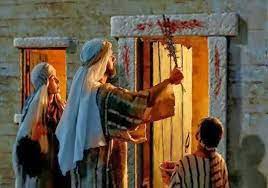
Just as the Children of God stained their doorways using a hyssop branch, so Jesus' blood stained the wooden cross on the left and right posts where He was nailed through the wrists. The blood from His crown of thorns strained the top of the cross. And when He asked for water just before He died, they lifted a sponge up to Him attached to a hyssop branch (John 19:29). So, the exodus Passover ritual was obviously only a shadow of the crucifixion of Christ. Jesus, as the only begotten biological Son of God was the unblemished lamb of God. His pure sinless blood would allow God’s righteous judgement and condemnation of all mankind to pass-over a believer and provide eternal life. Now at death, the spirit of a believer would exodus the body trapped in the bondage of sin and travel to the actual promised land which is Heaven and any place where God resides. So the term promise land was ultimately always a euphemism. The word land refers to a place in the presence of God. And the word promise was achieved through Christ on the cross. Abraham knew that the land of Canaan was not his ultimate destination but instead it was a land of rest far away. Thus Scripture tells us that, "... he, lifted up his eyes and saw the place far off ." (Genesis 22:4; Hebrews 11:8-10). He was looking at the highest mount known as Golgotha or Calvary located just behind Mount Moriah known as the Temple Mount. It would be Mount Moriah where he was to sacrifice Isaac. It would be Mount Calvary that would allow him and his people access to the promised land of peace.
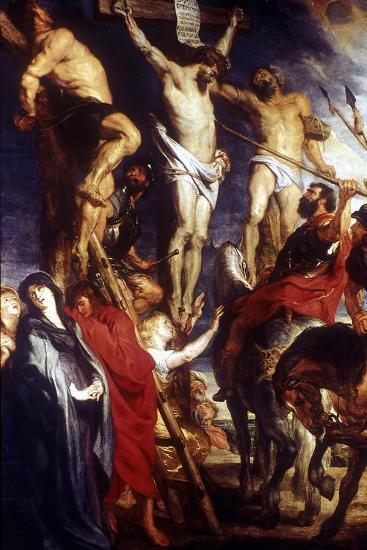
A person crucified by Rome had to be certified as dead in writing and witnessed by the entire execution squad. A squad consisted of a Centurion and four solders highly trained in the crucifixion process. Oral tradition states that a soldier by the name of Longinus, following official protocol, took his specially designed spear and ran it up through Jesus’ left side above the 5th rib and into His heart. If blood emerged, it meant that the person was still alive but would now immediately die. If no blood emerged it meant that the heart was no longer beating and the person was dead. In Jesus' case, what emerged from the wound appeared to be water mixed with a small amount of blood. This observation shows that the spear had pierced Jesus' heart but in doing so, it had to pass through the pericardial sac that surrounds and protects the heart. The liquid in this sac is clear as was noted by the disciple John who was an eye witness to Jesus’ execution (John 19:34).
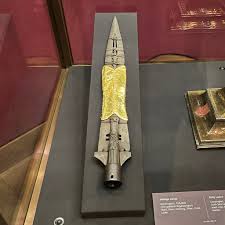
John also cited that the usually clear liquid had a small amount of blood in it. But for blood to have been in the fluid meant that Jesus’ heart must have ruptured while He was still alive. This may have occurred as early as the Garden of Gethsemane where His sweat emerged mixed with blood from the rupturing of skin capillaries known as hematohiorosis. Or, it may have occurred during one of His two scourging’s and beatings before His crucifixion ordeal (Luke 22:44).
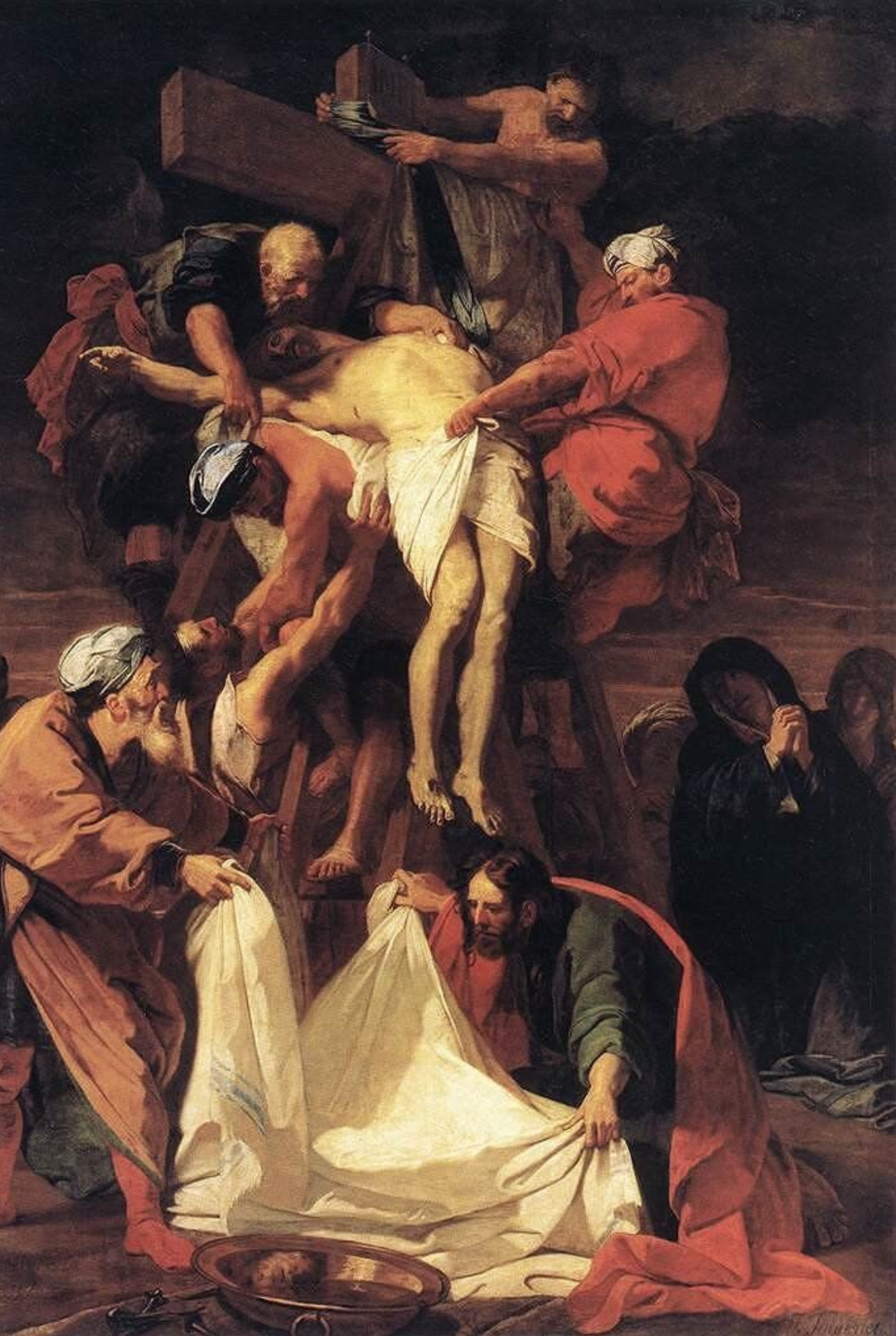
The three crucified men were now certified as dead and allowed to be taken down with their bodies remanded to their families. If the person was a Jew and no one claimed the body, it would be disposed of in one of two sites. One for those who died from beheading or strangulation and another for those who were stoned or burned. While Jesus was a Jew, He was declared a blasphemer and crucified by pagan Rome therefore, the Jewish authorities could not dispose of His body according to Jewish law (M. Sanhedrin 6:5-6, Flusser 1969: pg.119). Mary, the mother of Jesus, was at His execution as was the disciple John, Mary’s sister Maria, Mary the wife of Clopas and Mary Magdalene. All were allowed to stand by the cross as Jesus died (John 19:25). There were “many other women” followers of Jesus at the crucifixion, but because they were not immediate family, they were only allowed to watch from a distance standing behind the males in the crowd (Matthew 27:55).
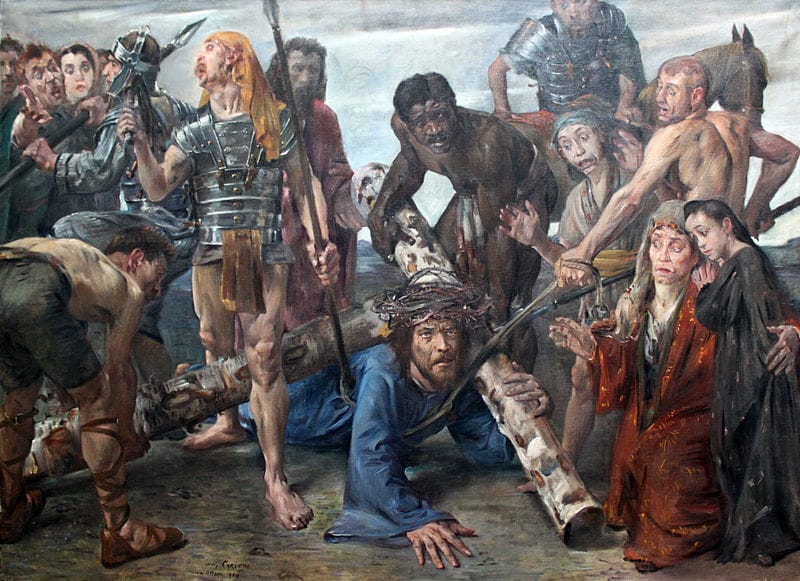
It is possible that Simon of Cyrene who help carry the cross of Jesus also stayed at the crucifixion sight. We know he was from modern day Libya and had traveled nine hundred miles to worship the Jewish God with his two sons Alexander and Rufus (Mark 15:21). We know that historically, the people of Cyrene were among the first Christian believers (Acts 2:10). Simon may have learned more about Jesus after the crucifixion and stayed in Jerusalem an additional 50 days to celebrate the Feast of Pentecost. If so, he and his sons may have witnessed the apostles speaking in tongues and participated in the mass baptism of 3,000 Jews.
On an intriguing note, in 1941, a first century Jewish burial cave was found in the Kidron Valley containing eleven ossuaries or bone boxes. It was determined that the family was from Cyrene. Engraved in Greek on one of the ossuaries was the name ‘Alexander son of Simon’ and a second time in Hebrew ‘Alexander the Cyrene’.
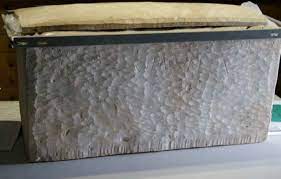
Jesus had been arrested, tried seven times (7 is the number of completion), convicted of blasphemy for truthfully saying He was the Son of God, and sedition for truthfully saying he was a King, scourged twice and crucified all in less than twelve hours. It is now just after 3:00 p.m. and Jesus’ body is still on the cross. His remains have been released to Mary his mother. John is with Mary as are other women (John 19:25). However, the disciples were all in hiding. What to do now?

Fortunately, Jesus had two wealthy and politically connected friends there at His crucifixion. While they may have been in attendance by happenstance, it is highly probable that their assistance was pre-arranged by Jesus to assist with His burial. One was named Joseph who came from the city of Arimathea in Judea. He was wealthy, a member of the Sanhedrin and had not voted for the execution of Jesus (Mark 15:43; Luke 23:50-51; Matthew 27:57). The second man was named Nicodemus who was a Pharisee, a member of the Sanhedrin and also a man of great wealth. Both of these men were secret followers of Jesus (Matthew 27:57; John 3:1). So, if Jesus’ disciples were going to stay in hiding, they would be forced to publicly step forward and become involved in a burial plan. They had less than a three hour timeline to accomplish this task. First, Joseph went to Pilate to formally request permission to take down and entomb the body of Jesus (John 19:38, Luke 23:52). Pilate agrees but only after he hears directly from the Centurion that Jesus’ death was certified and signed by the crucifixion squad (Mark 15:44).
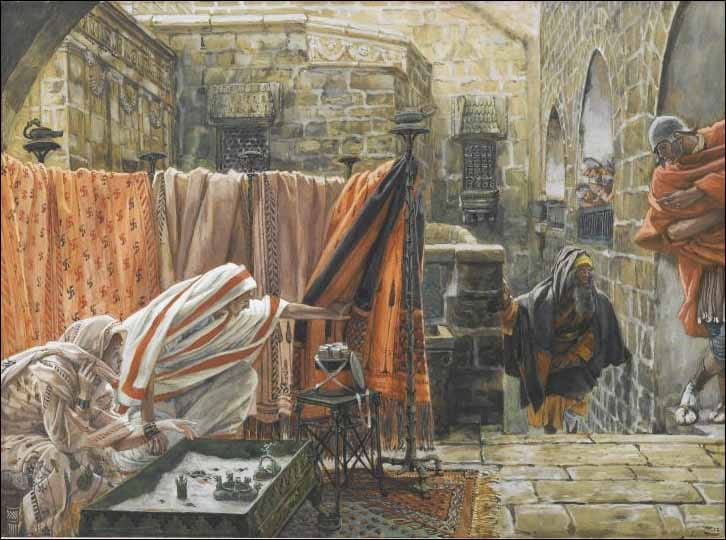
Meanwhile, Nicodemus also leaves the crucifixion site to purchase seventy-five pounds of fragrant myrrh and aloes, a customary Jewish embalming mixture (John 19:39). The two men then returned to the crucifixion site called Golgotha or The Hill Of A Skull. Please see related: "Golgotha Revealed" John stayed at the cross to comfort Mary and ensured that neither the Romans nor the Jewish leaders tampered with Jesus’ body.
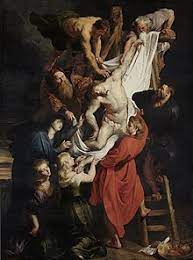
It is now approximately 4:00 p.m. and Joseph arrives with the permission document from Pilate to remove the body of Jesus from the cross. Nicodemus arrives with burial linen and traditional Jewish embalming oils and spices. Joseph takes the body down from the cross (Mark 15:46). Jesus’ body was then carried to a nearby tomb site for the embalming process and interment (John 19:41). Oral tradition states that His body was laid on a large flat stone protruding from the ground directly adjacent to the tomb. This stone is today referred to as the Stone of Anointing and is still in place next to the Tomb of the Sepulcher in Jerusalem.
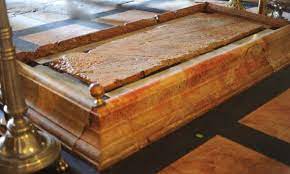
First century Jews embalm their dead if they could afford the expense. The poor were immediately placed by their family in a temporary mortuary chamber with a cloth over their head for three days. This was done to make absolutely sure the person was dead and their spirit had left the body as opposed to their being comatose or in limbo which was thought to be a state between Sheol, the land of the dead and the waking world. The Jewish tradition was to mourn the dead for three days (I Corinthians 15:4; Rabbinical haraita of Semahoth 8:1, Safrai, 1976: Pg. 784-785). Then, upon inspection, the body was wrapped in cloth and buried in a location arranged by the deceased family. This tradition to observe a body for three days to make absolutely sure it was dead was the reason Jesus did not resurrect Himself until day three.
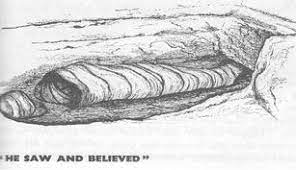
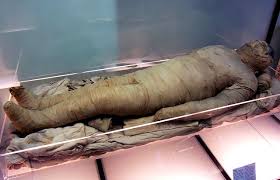
Wealthy Jews embalmed but not in the Egyptian tradition. Instead, the torso with its organs intact was wrapped. The limbs were individually wrapped. The process took time and skill (Matthew 27:59). As the body is slowly wrapped, the linen is folded in a way that created a continuous pocket or crease to hold the spices in place (Hachlili, 2005: pg. 480). The body is wrapped separate from the head. The head has a tourniquet cloth that wraps under the jaw and then up and over the head where it is tied (Talmud Babylonian, Shabbar, 151 a-b). This keeps the mouth closed. A second cloth or napkin was laid across the face of the deceased (Talmud Babylonian, Mo’ed Katan, 27a). When Joseph and Nicodemus had finished this process, they lifted the body of Jesus from the stone, took it into the tomb. This sepulcher was originally designed and paid for by the wealthy Joseph of Arimathea. There they laid Jesus' corpse on a narrow stone pedestal or shelf that was carved out from the tomb’s wall (Matthew 27:60; Mark 15:46).
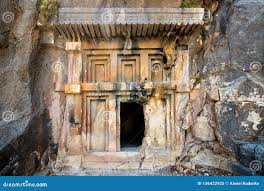
There is a common misconception about the tomb of Jesus. It is assumed that the tomb of an itinerant rabbi would be extremely simple. This was not the case with Jesus for two reasons. First, He was put in the new tomb of the richest man in Judah (Isaiah 53:9). So, this was not a natural cave nor a hole in the wall tomb like the one known as the Garden Tomb in Jerusalem. This would have been a first class mausoleum with carved steps leading up to an intricately carved entrance façade. This entrance would have included a stone door overhang. The doorway would have had carved columns on either side and a large stone door that could be slid open and closed. A person could walk upright through the doorway. Once inside the chamber, there was a 10' by 10' room or larger with a pedestal or shelf front and center. A body would be placed on this pedestal wrapped in a linen covering or shroud. The head would have a separate wrap. The family would check on the body each of three days to see if the head wrap had moved thus signaling that the person was still alive. This would not be possible in the case of Jesus as He died on Friday the day before at Passover. Jewish law did not allow a person to come in contact with the dead during a feast day. Therefore, the family would have to wait till Sunday to visit the tomb and check on Jesus' body. If, after three days the wrap had not move and rigor mortis had set in, then the body was officially declared dead. The body would then be covered with additional oils and spices and left on the pedestal for one year. Then a mortician would be allowed into the tomb to put the bones in a stone carved box or ossuary. The box would then be slid into a niche carved in the wall. Thus, a mausoleum could easily hold many generations of family members.
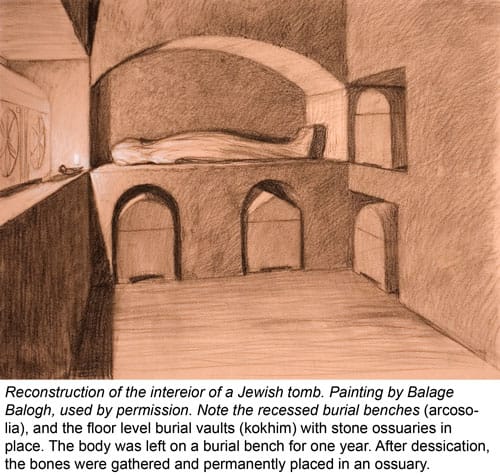
John tells us that Joseph had bought a parcel of land where he had a new unused family sepulcher cut out of stone. Also, the surrounding land was a garden that was evidently used to produce fruits and vegetables as Joseph had hired a person to manage the land (John 20:15). Jesus’ body was taken to this place because it was available and immediately adjacent to the crucifixion site (John 19:41). It was probably assumed that Jesus’ body would be permanently entombed in another location to be decided after the Feast of Passover.
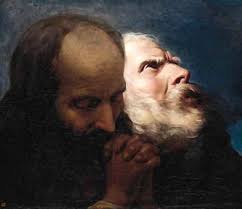
Joseph of Arimathea is said to have been the wealthiest man in Jerusalem and this was saying a lot as it was very expensive to live within the city limits. There was only so much real-estate within the four walls of the city and it was sold and bought relative to what the market would bear. Tradition states that after the resurrection, Joseph donated his tomb to the family of Jesus. He would have done this for two reasons. First, as a follower of Jesus, this generous act on his part would provide an appropriate location in which to bury Jesus’ family members. Secondly, the tomb had instantly become a revered site for the followers of Jesus and a curiosity for others. He understood that his tomb had now become a holy memorial to the only resurrected founder of a religion. So, it would be better for him to simply buy another plot of land adjacent to his original tomb site and excavate a new one for he and his family to use. And this appears to be exactly what he did. The Chapel of the Tomb of Joseph of Arimathea is located directly behind the tomb of Jesus at the western end of the Church of the Holy Sepulcher. It is a first century Jewish tomb with five burial chambers two of which are accessible and open to the public.
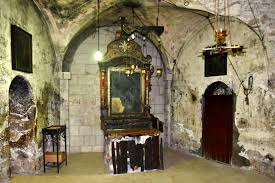
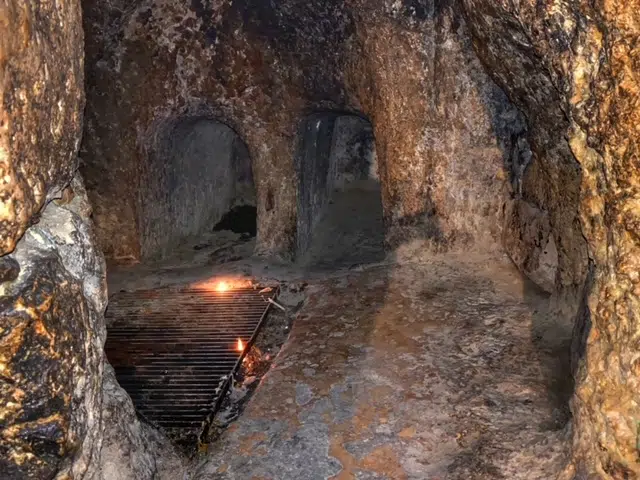
The entourage of Jesus’ female followers had witnessed the execution, the embalming and the placing of Jesus’ body in the tomb. Now they watched as Joseph and Nicodemus rolled then work the stone door into place sealing the tomb (Matthew 27:60; Mark 15:46).
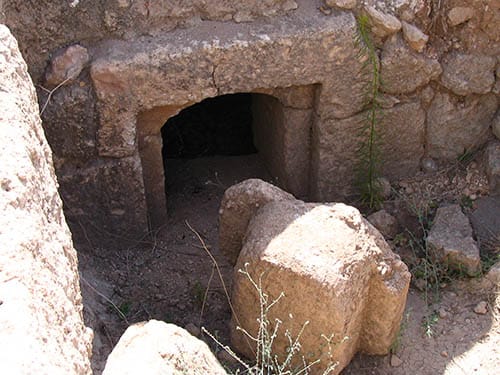
Most commonly, a sepulcher entry door was a thick cube of stone at one end with flanges that stuck out from three sides. This makes the door look somewhat like a champagne cork. The cube would be slid into the opening and the outer flanges would ensured a secure tight seal intended to keep in smells, and keep out both scavenging animals and anyone who might attempt to tamper with or steal the body (Mark 15:47; Luke 23:55). Stealing and holding a body for ransom was a very real problem in the first century. However grave robbing was rare in that traditionally, Jews did not place objects of value on or around the deceased.
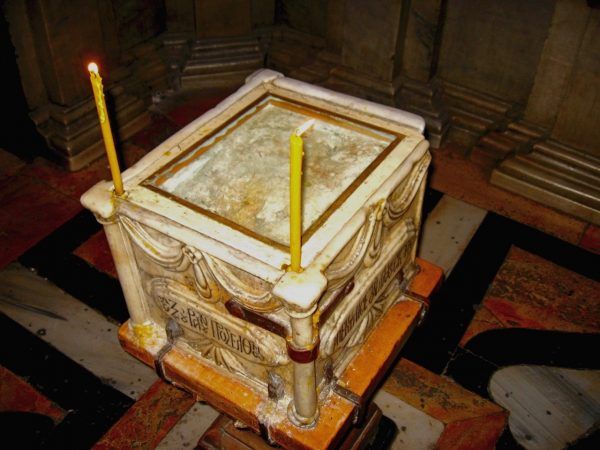
The remains of this tomb door are currently within the Edicule of the tomb, in the Chapel of the Angel aptly named as the angel that removed the stone then sat on it (Matthew 28:2). The Chapel has an alter with a large marble box that holds a rough-hewn cube of limestone called the Angel’s Stone which is the remains of the stone door. Celtic bishop Arculf visited the Edicule in 680 A.D. and wrote that the large stone had been cut into two manageable pieces. One was displayed in the Edicule and the other in the church’s great rotunda.
It is now approximately one hour until the beginning of Passover. The funeral procession has left, the sun is setting and there is a chill in the early April air. Mary Magdalene and Mary, the wife of Cleophas, sit on the ground with their backs up against the tomb wall and weep for their dead spiritual leader (Matthew 27:61). Friday morning had begun with news that Jesus had been arrested and ended on an unbelievably tragic note. Jesus’ followers had watched with excitement as He had entered Jerusalem only five days earlier with enormous public adulation and great expectations concerning the dawning of a new day for Israel. Their Messiah and King had finally arrived (Matthew 21:1-11; Zachariah 9:9). All of His followers had made plans to celebrate this Passover with their Master and Lord. How had it all gone so tragically wrong so quickly?

John tells us that this particular Passover fell on a Saturday or the Sabbath. Therefore, it is referred to as a “High Sabbath” as it was also the day of the Passover Feast (John 19:31). This seemingly insignificant note by John inspired by the Holy Spirt, will greatly help us to pin point the exact year of the crucifixion. The Jewish calendar is based on a 30-day month and a 360-day year. This was true of all ancient calendars as they could only gage time based on observing the phases of the moon. However, because there are actually 365.4 days in a year, the ancient calendars needed regular adjustments. While Passover could occur any day of the week just as a person’s birthday does, it had to take place on a full moon. And the full moon had to always occur on the 14th day of Nisan. Sometimes this date would fall in late March and sometimes in April. The fact that this particular Passover fell on Saturday is somewhat rare. It may happen three times in 10 years or only one time in 20 years. But it is this note by John that allows us to now easily and accurately discover the exact date of Jesus’ crucifixion. I say easily because with the use of modern computer driven astronomical software, all we need to do is to run the phases of the moon backward to the beginning of the first century. What we are looking for is a full moon on the 14th of Nisan which is also on a Saturday. And there it is! The computer shows with absolute certainty that the date of Jesus’ crucifixion was Friday, April 3rd 33 A.D.
Previously, the concern about this date has been that it does not allow Jesus to have been in the “heart of the earth” for three days and three nights before His resurrection. The three days and three nights in the tomb are easily explained once you understand how the ancients considered time based on partial days and nights versus the modern conception of a 24-hour day and night. Jesus did say He would be in the heart of the earth three days and three nights but, He did not say three 12-hour days and three 12-hour nights (Matthew 12:40). Nor would first century people look at this expression that way. At the time of Jesus, the Jews considered any part of a day to be seen as a full day. A year was also seen in this same way. For example, if a ruler died in July of 30 A.D., he was still credited as being king for that entire year. Please see Related: Three Day and nights )))))))))))
On Saturday, April 4th at 6:00 p.m. the Feast of Passover had ended. Passover was the first of three consecutive feast celebrations. The day of Passover was the start of the week long Feast of Unleavened Bread. It required every household to deep clean their homes in order to symbolically remove leaven or sin from the lives of the family. Note that Jesus was buried in a new, clean tomb free from corruption or leaven (Luke 23:53). The third Feast that followed on day three or in this case on Sunday, was called the Feast of First Fruits. This required the Jews to go into the fields and harvest some of the first heads of grain, bundle them into sheaves and take them to the temple as an offering. Thus the old gospel lyrics, “bringing in the sheaves”. Jesus would arise on Sunday or day three and be the First Fruit singular of the Resurrection (1 Corinthians 15:23). It was on Sunday the first day of creation that the Holy Spirit of God hovered over the surface of the waters and the Word of God or Jesus said, “Let there be light” or in the Hebrew, “Be light” (Genesis 1:3). God formed the body of Adam from the earth and bending over him, breathed life into his nostrils the breath of life (Genesis 2:7). On an interesting note, newborns always breath through their nose for the first several months of their lives. The angel Gabriel told the virgin Mary that the Holy Spirit would overshadow her and she would conceive life. On the first day of creation, the Spirit of God moved or hovered upon the face of the waters. On Sunday morning in the tomb, the Holy Spirit of God would overshadow the body of Jesus and breathe life into Him. And it was on Sunday that Jesus arose to give spiritual light and eternal life to mankind.
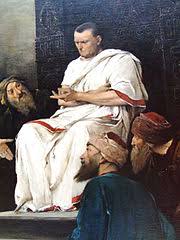
The next day after the crucifixion, the Chief Priests and Pharisees went to Pilate with a request (Matthew 27:62). Remember, for the Jews a day began at sunset therefore, the religious leaders must have gone to Pilate at sunset to ask that a guard be put on His tomb. They would not have waited till Saturday morning to go to Pilate for two reasons. First, Jesus' followers might steal His body Friday night and then claim He had risen from His grave. Second, Saturday was Passover and Jewish law strictly forbids a person to travel more than a total of 1,017 yards on the Sabbath. And, just a importantly, and a meeting with a pagan Roman ruler would cause a Jew to become ritually impure and instantly disqualify them from participating in the Passover rituals. So, they must have met with Pilate during the in-between time of the very end of Friday and very beginning of Saturday.
At 6:00 p.m. on Friday, Jesus had now been in the tomb one day or Friday which officially ended at 6:00 p.m. and now was beginning His first night in the tomb or Saturday night. Again, a partial day was considered a day by first century Jews. The religious leaders reminded Pilate that Jesus had publicly stated that He would rise from the dead on the third day or Sunday (John 2:18-22). Neither the Jews nor Rome thought this was a possibility, but the Jewish leaders explained that Jesus’ followers could come and steal the body and then say He had risen. Therefore, they requested that an official Roman Watch be stationed at the tomb for 3 days (Matthew 27:64). Pilate agrees and orders the tomb to be officially sealed and guards to be stationed at the site. A Roman Watch consisted of sixteen soldiers in groups of four with a change of guard duty every three hours (Matthew 27:65-66). The followers of Jesus were apparently unaware that an official Roman Watch had been stationed at the tomb as Passover lasted until Saturday at sundown. Only then could they, according to Jewish law, both travel and become ritually impure by visiting a cemetery. And, since it would be dark at 6:00 p.m. Saturday evening, they would have to wait until morning, or Sunday to go visit the tomb site to mourn and pray.
On Sunday, April 5th, a group of women had prearranged to meet very early before sunrise and walked together to Jesus’ sepulcher (Matthew 28:1; Mark 16:2; Luke 24:1; John 20:1). Mary Magdalene and Mary, the mother of James, had bought spices with which to re-anoint Jesus’ body (Mark 16:1; Luke 24:1). They probably felt the original burial ritual had been rushed in an undignified manner. As they walked, they expressed concerns to each other as to how they would be able to remove the heavy tomb door out of the opening (Mark 16:3). This is proof that they were completely unaware that a Roman Watch had been put on the tomb. These pious Jewish women would never knowingly go to a remote site where sixteen Roman guards were camped. Also, it would be a capital offence to break the Roman clay seals on the tomb door. So, the women were obviously expecting Jesus to be in His tomb and not expecting to find Roman guards at the site with the door sealed.
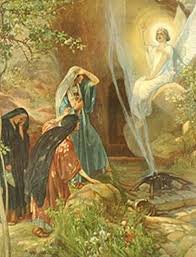
The first rays of the sun had not quite risen above the horizon. They were looking at the tomb in the distance when they felt an earth tremor. They stopped walking and waited for it to subside. Earth tremors are not rare in the area of Jerusalem. A major fault line runs down the Jordan River and another fault line runs through the Mount of Olives. As they stood still looking in the direction of the sepulcher, they saw a man descending from the sky down to the door of the tomb (Matthew 28:2). They assumed that this was an angel sent from the Lord. They watched in astonishment as the man appeared to remove the heavy stone door and then sat on top of it. The angel was dressed in white clothing that radiated flashes of light similar to distant storm lightening in the sky.
Being in a group and at a distance, the women decided to continue to go forward cautiously to the now open sepulcher. Although the area was still in shadow, the light that radiated from the angel lit up the exterior of the tomb. The women also saw that the interior of the tomb was lighted by the presence of a second angel. It was clear that the body of Jesus was gone from the shelf (Mark 16:4-5; Luke 24:2-3; John 20:1). Mary Magdalene, standing at the doorway behind the other women, clearly sees the empty tomb shelf and immediately turns and runs back to Jerusalem to report this to the disciples (John 20:1-2). As far as Mary was concerned, the angel only opened the tomb door in order to show the women that Jesus was not there. Mary hastily and wrongly assumed that the body had been stolen. By whom and for what reason was unclear to her. Did the Roman soldiers take it for ransom money? Did the Jewish leaders take it to desecrate it in some way? Or, did Joseph remove it to some other location? After all, it was his family tomb and putting Jesus there was only a temporary fix to an immediate problem. Mary is now gone leaving the other women at the tomb.
We know that the two Mary’s were accompanied by “others” (Luke 24:1). We do not know who these people are but we can imagine it was the same women who attended the crucifixion. These women now notice that there are Roman soldiers in the tomb garden area. While most had run away with the arrival of the angel, some stayed to fight but were now either unconscious or in a comatose state of shock (Matthew 28:4). The Angel said to the women, “Jesus is not here for He is risen. Come and look.” (Matthew 28:6; Luke 24:5). Some of the women enter the tomb while others can only peer in from the doorway. From their vantage point at the entrance, they only saw one young looking man in white shining cloths sitting on the right side of the now empty body pedestal. The women were scared, confused and excited at what they had heard and seen (Luke 24:4). The man told them not to be scared and to come and look at where Jesus’ body once lay (Mark 16:6).
They entered further into the tomb where they could now see there was a second man, also in shining clothes sitting at the other end of the pedestal (Luke 24:4). The two angels were symbolic of the Ark of the Covenant. The top of the Ark has two Cherubim kneeling and facing each other. Their wing are in a forward position. It is between their wing that the Mercy Seat of God is located. Once a year on the High Holy Feast of Yom Kipper, the High Priest sacrifices a male goat. He then takes the blood and sprinkles a drop on the Mercy Seat. This is done to cover the sins of the nation committed over the past year. This sacrifice is also a request that God allow His people another year of life. The location of the Mercy Seat was the exact location where Jesus’ body once laid with the two angels now sitting on each end of the bench.
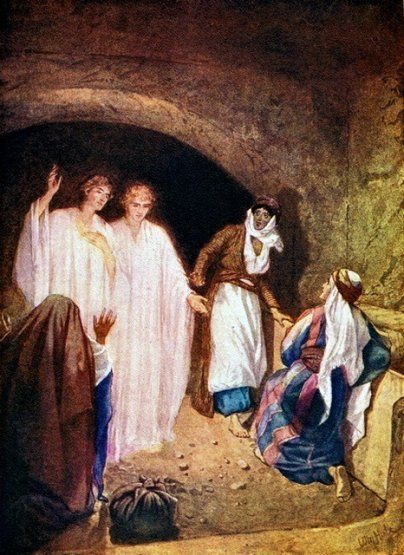
Thinking they were in the presence of messengers from God, the women bowed their heads in respect to the two angels and in praise of God (Luke 24:6). Apparently, the two men spoke simultaneously which would have been unsettling to hear. They said in unison, “why do you seek the living among the dead?” (Luke 24:5-7). We possibly see these same two men or angels speak in the same fashion at Jesus’ ascension (Acts 1:11). They go on to say, “He is not here but risen …remember He said… the Son of Man must be crucified and on the third day rise again” (Luke 24:5-8; Matthew 12:40). “Now, go and tell His disciples, and Peter, that He has risen from the dead and to go to Galilee to meet Him.” (Matthew 28:7; Mark 16:7). Peter was singled out because Jesus knew that he no longer felt he had the right to be considered a disciple. While Judas had betrayed Jesus, Peter had denied Jesus 3 times! Jesus apparently met privately with Peter before He appears to the disciples later that evening (Luke 24:34; I Corinthian 15:5). He know doubt showed compassion for Peter through forgiveness, restoration and encouragement.
The women leave the sepulcher and go to tell the disciples what the men told them (Matthew 28:8; Mark 16:8; Luke 24:9; John 20:2). Mary is already meeting with the disciples and is telling them that Jesus’ body has been stolen. But this is not what the women were told by the angels at the tomb. Mary says to Peter and John, “they have taken the Lord out of the sepulcher and we do not know where they have put Him” (John 20: 1-2). The we Mary is alluding to are the other women that were with her at the tomb. However, the women who stayed at the tomb now know exactly what has happened to Jesus and are now on their way back to the city to tell the disciples the exciting news.
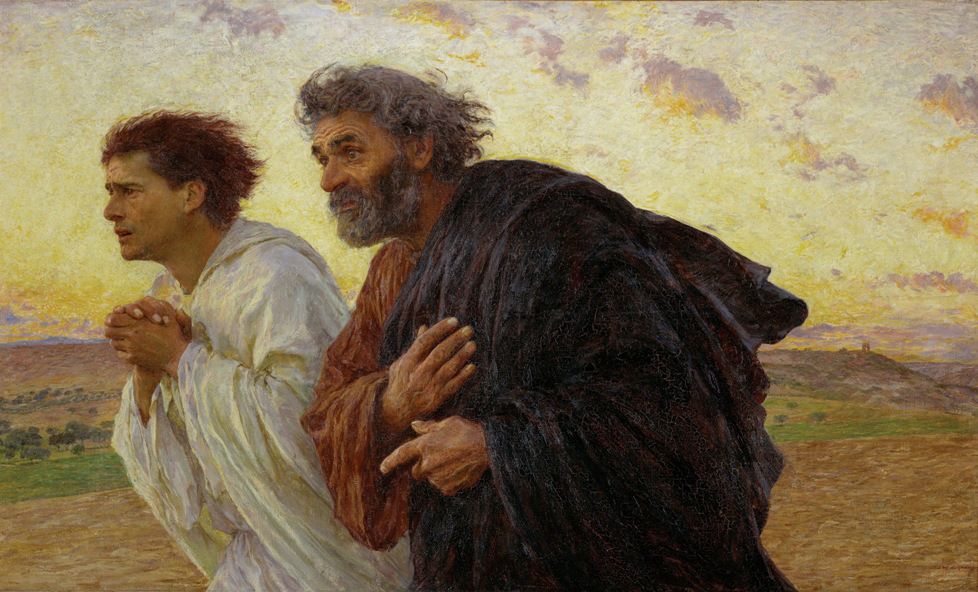
Peter and John immediately get up and, leaving Mary in the room, run to the tomb to find out for themselves what is going on. John, the younger of the two, out runs Peter and is the first to arrive at the tomb but he stops short of going in (John 20:3-4). This could have been either out of respect for the holiness of the site, or because of Jewish law concerning defilement associated with a dead body, or because he was young and just plain scared. At any rate, John stopped at the entrance of the tomb and only looked inside. However, Peter being Peter, pushed past John and went straight into the tomb (John 20:5). What Peter now sees both astonishes and confuses him.
He sees the linen body wrappings neatly folded on the body shelf (John 20:6). The head napkin or head cloth was still tied and at the head of the body shelf (John 20:7). The body wrappings were separate from the head cloth. John now goes into the tomb and what he saw immediately convinced him that Jesus had risen from the dead (John 20:8). But Peter was still not sure what to think. Here is what they saw.
The description states that the burial wrappings were laying on the shelf pedestal, which would rule out that the body was stolen. No one would have taken the time to unwrap a body and then remove it. However, the wrappings were still folded as they had been when Nicodemus and Joseph embalmed the body three days earlier. In other words, it looked as if the body had somehow passed through the wrappings and the wrappings had then collapsed in place just like a balloon collapses when you let the air out. The wrappings were in the shape of a man. The problem was, the body was gone! But how was this possible? The jaw cloth was lying at the head end of the shelf and it was still wrapped and tied together. The cloth had simply collapsed onto itself (John 20:7). The wrappings were there, the seventy-five pounds of spices were there and emitting a wonderful fragrance in the air, but there was no body! Peter and John saw no angels, no corpse, no soldiers and no women. Just a quiet, aromatic and deserted grave site. They decided to go back to the place where they were staying and report what they saw to the other disciples. The disciples were probably not staying in the upper room as Judas would have told the Jewish leaders about that location.
As Peter and John leave the tomb, Mary Magdalene is now on her way back to the sepulcher. She had told the disciples in hiding what she saw. but they did not believe her (Mark 16:11,14). The group of other women are still walking towards Jerusalem to tell the disciples what they saw at the tomb and give them the message the two angels told them to relay. Peter and John are also walking back to Jerusalem to report to the nine apostles (John 20:10). Mary Magdalene now arrives back at the tomb site and is alone. The rays of the rising sun just barely above the horizon now cast long shadows over the garden. The early April morning air is still with a slight chill. She is emotionally drained. The thought that her precious Lord’s body has been taken by someone and put in some unknown location causes her to once again begin to weep. She walks slowly to the empty sepulcher sobbing. She stoops down to look once more at the empty tomb (John 20:11). But this time, as she looks in, she sees two men dressed in white sitting at the head and the foot of the pedestal where Jesus had once laid (John 20:12). These are the same two men that the other women saw earlier at the tomb. Mary is probably thinking that these two men are part of the abduction scheme and have now come back to the tomb to ask for a ransom. Remember, angels can look like men (Genesis 18:2; Hebrews 13:2).
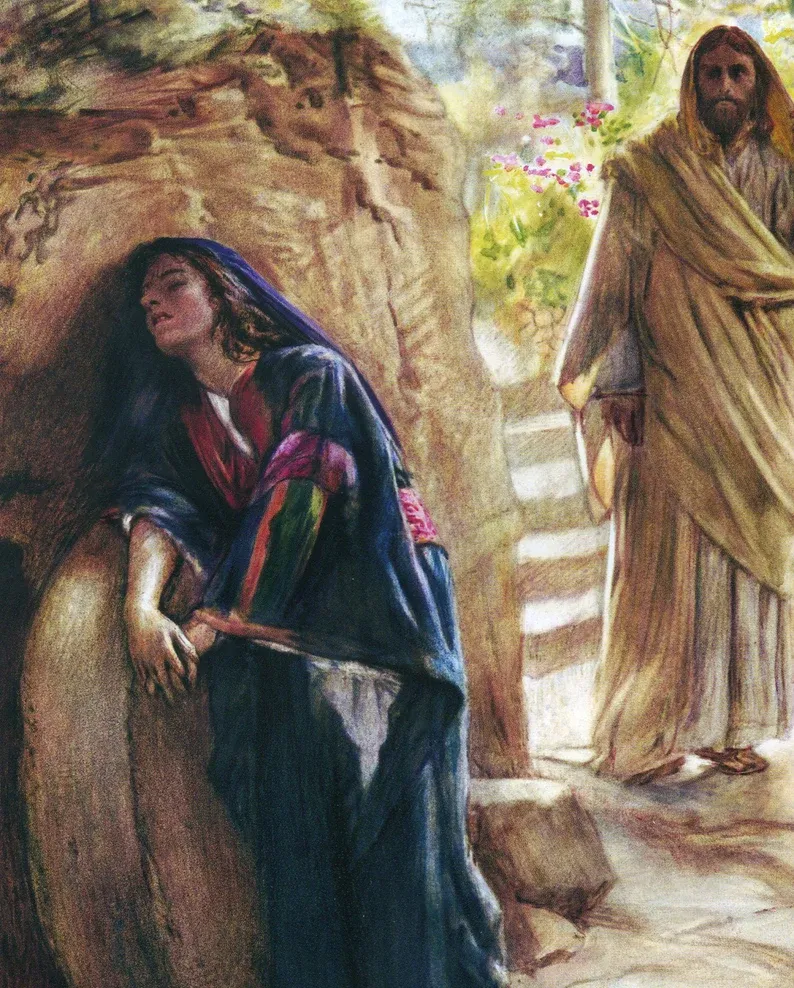
Mary now notices the two men are looking past her or she senses that someone is standing behind her. She turns around and sees a third man. The man was Jesus, but Mary does not recognize Him. There are a number of reasons for this. The first might be that Jesus has His outer coat hood up over His head because it was cold. If the rising sun was behind Him or to His side, His face would have been in shadow. Also, Mary had been crying for over an hour and her sight may have been effected. Or, she was just simply not expecting to see a living Jesus. Lastly, we know that Jesus was badly beaten by the religious leaders and scourged by his Roman executioners. They may even have pulled out His beard (Isaiah 50:6; Matthew 26:67). So, even though Jesus was alive and well, this does not mean His body did not still carry the scars of His crucifixion ordeal. In fact, we know that Jesus did keep His crucifixion scars in order to prove to His followers that He was Jesus and He was truly alive. He also had to eat food each time He appeared after His death to prove that He was not a ghost (Luke 24:37). It is sad when you consider that the only things that Jesus took back with Him to Heaven were His crucifixion scars given to Him by mankind.
Jesus now says to Mary, “Who are you looking for?” Mary evidently thinks that the man is either the hired keeper of the garden site, or he is part of the ransom scheme, or both. Mary then said to the man, “If you have taken Him from the tomb, tell me where He is, and I will take care of His remains” (John 20:15). Jesus then says to her in a calm gentle voice, “Mary” (John 20:16). She instantly recognizes His voice just as everyone would instantly recognize the voices of their father or mother no matter how much time as passed since they last heard them speak. Scripture tells us, “…His sheep… know His voice” (John 20:4). She looks up with a start and says “Master?” or Rabboni. She then rushes towards Him (John 20:16). Mary is now the first person to see Jesus after His resurrection and this is the only notation repeatedly cited in all four Gospels (Mark 16:9). Not His Mother, His brothers and sisters nor Peter or John. It was Mary, a humble devoted female follower that always referred to Him as her Lord (John 20:13,18). As Mary rushes towards Jesus to embrace Him, He quickly stops her (John 20:17). It is not that He cannot be touched, He simply wants to ascend to God the Father as soon as practical. He tells Mary “Do not touch me for I have not yet ascended to My Father, but go to my followers and say to them that I ascend to My Father, and your father; and to My God and your God. This phrase seems to repeat itself but there is a reason Jesus said it the way He did. Jesus, has an extremely different relationship to God the Father than we do.
Jesus is the Word of God, therefore, He was eternally one part of the Godhead. The spirit of The Word that indwelled Christ was not created by God. His spirit was always with God as the Word of God. Jesus spoke all things into existence with the command of God the Father and the creative power of God the Holy Spirit (John 1:1). His earthly body was created in part by Mary a created being and a daughter of man or Adam. Her egg was inseminated by the Holy Spirit so that God the Farther was Jesus biological father. He was therefore part man and part deity. Part earthly and part heavenly. When Jesus called himself “the son of man” He was referring to the part of Him that came from Mary and the fact that as a man, He would voluntarily sacrifice himself for all mankind. When He called Himself the “Son of God”, He could do this because God was His biological father. When God calls Jesus His “only begotten Son” He did this because Jesus’ was His only human biologically begotten son.
Mary leaves to go and tell the disciples that she had seen the risen Lord and the things He said to her (John 20:18). Jesus then disappears from the tomb site and immediately appears to the women who had left the tomb and are now almost entering Jerusalem. He greets them with a simple “Hello!” as if His resurrection and appearance should have been expected. The women fall down and, “held Him by the feet and worshiped Him.” Jesus told them not to be afraid and to go and tell His disciples that they should go unto Galilee, and there they will see Him (Matthew 28:9-10).
It is at this point Jesus had completed His earthly mission to redeem humanity from their sinful condition. The sign that His mission was successful and accepted by God is shown by God resurrecting Him from the dead. He was now required to ascend back in to Heaven. This would be the first time He had ascended into Heaven since He left there thirty three years earlier. It was at that time He descended to the earth in His spirit form to indwell the newborn human body created for Him by the Holy Spirit and Mary. He would now be ascending in His resurrected immortal body that He received at His resurrection. His body required this transformation in order to withstand the physical stress associated with His rapture. Just ascending 20,000 feet into the earth’s atmosphere would kill any human due to a lack of oxygen and a temperature of -12 degrees. He would now travel out of time and space into eternity where Heaven is located. Once again, Jesus is a model as to what we will look like in our resurrected bodies and why we have to be translated in order to physically withstand being raptured into heaven (I Corinthians 15:51-53). Jesus was destined to appear before the Throne of God in order to consummate the Everlasting Covenant created by Himself as the Word of God in perfect unison with God the Father and God the Holy Spirit.
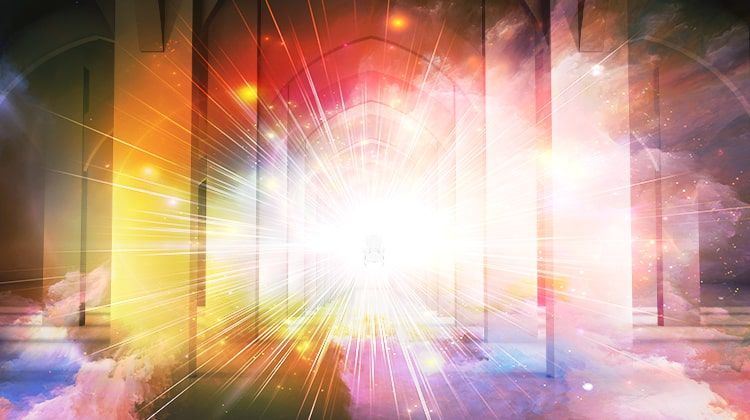
The eternal Godhead was now reunited with the return of The Word of God to heaven even though His spirit was still incapsulated by the physical body of the man known to the world as Jesus. He now stands before the Throne of God with the flame of the Holy Spirit enveloping the floor of the surroundings (Revelation 4:2-5). The Ark of the Covenant was present as part of this auspicious ceremony. This was the original Ark that Moses saw in Heaven while on Mount Sinai. A reproduction of this Ark based on Moses’ recollections was housed at the Temple in Jerusalem inside a small room called the Holy of Holies. This Ark contained the two stone tablets of the Law, the staff of Aaron and a jar of manna. Once a year during the Feast of Yom Kippur, the High Priest was allowed to approach the Ark. It was at this time and only at this time that he would sacrifice an innocent male goat on behalf of himself and his people. He would then take a small amount of the goat’s blood and pass behind a 3” thick vail that separated the Holy Place from the Holy of Holies which contained the Ark. He would then place a drop of the blood on the Mercy Seat located on the top of the Ark between the outstretched wings of two kneeling golden cherubim ( Exodus 25:17-22). He performed this most sacred of all Jewish rites in order to appease God so that He would cover over the sins of the people for another year. This ritual was always just a shadow of the actual event that was now taking place in the actual Holy of Holies or Throne Room of God in Heaven.
This ritual involved only God the Father, God the Word and God the Holy Spirit. Jesus now approached the heavenly Ark of the Everlasting Covenant as the High Priest of mankind in the Order of Melchizedek. The Levitical High Priest of the Jews was always only been a temporary shadow of this event where the Messiah as King and Priest in the Order of Melchizedek, becomes the Eternal High Priest of God on behalf of mankind. It was at this moment that Jesus, the Word of God, the biologically only begotten Son of God, Eternal High Priest and intermediary for mankind, took a drop of His own holy, precious and pure sin free blood and placed it on the Mercy Seat of the Ark. This most Holy of all sacred ceremonies concerning mankind, would have at long last, consecrated the Everlasting Covenant that was agreed upon by the Triune Godhead before the creation of the world (I Peter 1:20; Hebrews 9:24, Hebrews 13:20).
This Covenant or agreement concerning the eternal life of mankind could only be consummated with the voluntary self sacrificial blood offering from a sin free High Priest. This was the only action that would be deemed acceptable by God to atone for all the grievous and intentional sins committed by mankind throughout the long sorted history of humanity. The final words of Jesus on the cross begin with the phrase, “It is finished” (John 19:30). Jesus was publicly proclaiming to God the Father and humanity that he had satisfied all the stipulations of this Covenant up to and including His sacrificial death as High Priest of mankind (John 1:30: Hebrews 6:20, Hebrews 8:1). He was signifying that humanity was now sanctified as righteous in the eyes of God and worthy of eternal life in the presence of the Godhead. The High Priest of the Jews could only sacrifice an innocent goat once a year on behalf of his nation to cover the sins of his people from one year to the next. Jesus, on behalf of all humanity, had voluntarily sacrificed himself as a sinless High Priest to for all the sins of mankind eternally.
It was at this moment in eternity that Jesus the Christ was exalted by the Godhead to the highest place or position of Heaven. The word exalted or huperupsoo means in the Greek, “to raise up to the loftiest or highest of the possible heights”. In today’s vernacular we would say Christ was super or mega exalted to a height in position or rank that was not only the highest possible in Heaven but was created by God the Father especially for Christ to show His approval, respect and adoration of His Son for what He had accomplished on His behalf. He had met and surpassed God’s expectation to the point of absolute perfection. God the Father was the only entity that could fully appreciate all that the Word of God had accomplished. As The Word, He was willing to strip Himself of His glory as deity for the one and only time in eternity, step down from the Throne of God, humble Himself to become as one of His creations, humble Himself yet again by becoming a servant to His creations, live among the most sinful of His creations and even stoop to the ground to wash their filthy feet. He allowed Himself to come under the judgement of unrighteous men both religious and civil, to be tortured by them and ultimately be unjustly nailed to a tree while being publicly mocked. He would be deserted by man and God as He was slowly suffocating to death. He would die with the sins of the world placed on His shoulders. He would be buried in a borrowed tomb, abandoned and left for dead by His disciples and followers.
However, God knew that these acts of humility, depravation and self-sacrifice were made out of the Word’s love for His creations. Therefore, these actions were seen by God as so heroic and magnanimous that they were deserving of the highest positions of power and glory in heaven and on earth. Jesus as the Word of God, sat on the Throne of God with God the Father surrounded by the power of the Holy Spirit. The Throne of God was already located in the heights of heaven. There was no other entity that was above the throne of God. While there was a space above the throne, it was created by God, unoccupied and only existed in order to frame the throne of God when looking at it in its totality. Lucifer, the fallen Arch Angel, noticed this area above the throne of God and eventually imagined himself having his throne located there above God and all His creations. This prideful ambition of Lucifer’s is what caused him to fall from grace (Isaiah 14:12-14). Jesus was now exalted to that space to be the physical representation of the spiritual Triune Godhead. In other words, to see and hear Jesus was to actually see and hear the Godhead. Jesus was and is the physical manifestation of God (John 14:8-10, 14-15; Philippians 2:8-10, I Corinthians 15:26-29).
This is not to say that Jesus as the Word of God, is above God the Father and God the Holy Spirit. He is not and could never do that because these three separate entities are inextricably and eternally joined in perfect unison and accord with each other. This only means that Jesus is now eternally the physical representation of the Godhead for mankind to see and have a personal relationship with. The Word of God that once, in His spiritual state of being, sat on the throne with God the Father, has now become the human physical representation of God. His reward for the completion of His mission was His appointment by God to serve the personification of God for His human creations to know and worship. To worship Christ is exactly the same as worshiping God. There is no difference except that a person can see and come to have a personal relationship with Jesus. God is spiritual and the depth of His being is so incomprehensible that the mind of man cannot begin to contemplate, know or understand the unending complexities that are God the Father. But we can now know, love and worship that part of our creator or Jesus who spoke our physical creation into existence (John 1: 1-3).
Because Jesus has been exalted by the Godhead to the highest of heights, this is why it is said that He is Lord over all other lords and King over all other earthly kings or rulers and that every knee will bow to His name in heaven, on earth and under the earth or in Sheol (Romans 14:11). Jesus was and is the physical mirror image of a spiritual God the Father and God the Holy Spirit. Jesus glorified God while here on earth and God now glorifies Christ with His return back to Heaven. This title given to Jesus is a unique one-off honor in gratitude for the mission He had voluntarily taken on and the degree of perfection to which He had accomplished it. The followers of Christ will now also be honored above all of God’s followers (Matthew 11:11). They will be rewarded for their unfailing faith in His promise of a great reward even though they may have experienced a lifetime of adversities. They will also receive rewards for all the good works or good fruit they produced in spite of their trials and tribulations. While one does not attain eternal life through works, they will be rewarded for works as they are outward physical proof of a person’s inner spiritual faith and dedication to the philosophies of Christ. Just as the physical Jesus was the biological Son of God, we as His followers are also considered the physical children of God. Because Jesus was indwelled with the spirit of the Word of God, He remained a member of the Triune Godhead. When Jesus sacrificed Himself for our sins, two things occurred. We were spiritually cleansed from our sins thus we became spiritually acceptable to the Godhead. Because we are also physical, when we are married to Christ, we are physically adopted into the Godhead and become legitimate heirs or the Children of God with all the rights and privileges that are ours as His children. Christ was resurrected from the dead and so also will we be resurrected by Him from the dead (John 11:25; Revelation 3:21). Christ was exalted and we will be exalted. Christ is eternal and we will exist eternally with Him. Wherever He is, there we will also be (John 14:3). Christ is now in Heaven sitting at the right hand of God and interceding as High Priest on behalf of mankind. Whether we die or are raptured, we will immediately be with Him in Heaven (II Corinthians 5:8). When He is married to His Church, we will be there (Revelation 19:7). At the Marriage Supper of the Lamb, we will be there with Him. When He returns to the earth at His Second Coming, we will be with Him (Revelation 19:14). When He reigns on earth for 1,000-years or the Millennial reign, we will be with Him. When the millennial reign ends and He surrenders all creation to the Godhead, we will be there with Him (I Corinthians 15:27-28). And we will be with Him through a never-ending series of ages upon ages eternally unfolding as is the plan of God for His children (John 14:1-6; I Cor 15:28).
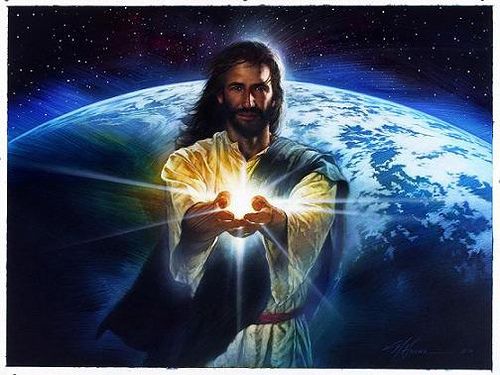
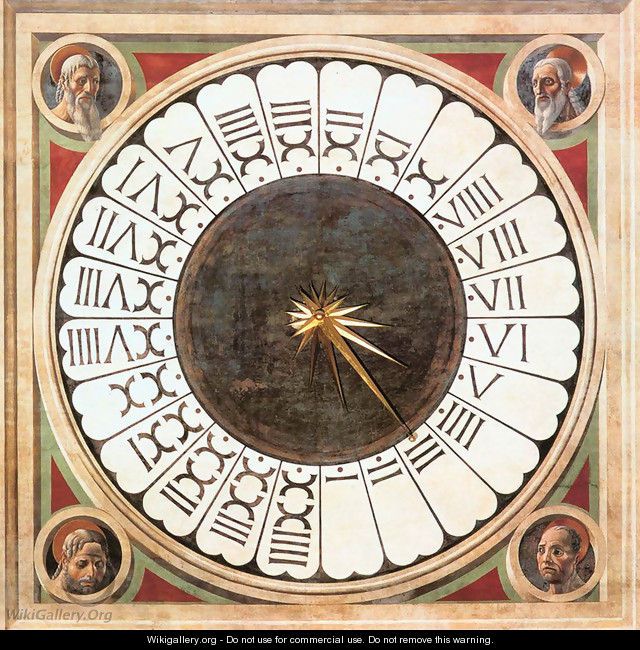
On the morning of resurrection Sunday, Jesus ascended into the Throne Room of God, approached His Father and using His own sin free blood, put a drop on the Mercy Seat of the Ark of the Covenant. In doing so, He consecrated or sealed the Everlasting Covenant that was agreed upon by the Triune Godhead before the creation of the world (John 17: 5, 24; 1 Peter 1:20; Hebrews 9:24, Hebrews 13:20-21). This was unlike any of the old covenants that God had previously made with His people. This was a new, more perfect Covenant that took man and his lack of faith and sin nature out of the formula. Instead, Jesus made this Covenant with God on behalf of man. Thus, God will never again be forced to break this Covenant because man did not keep his part of the agreement. This is because man is no longer relied upon in this Covenant. Instead, Jesus has prepaid the full price for all the sins that man will ever commit thus, this Covenant can never be broken. Now, the only thing required of man is that He have faith in what Jesus has accomplished and accept the offer of eternal life. This offer could not be made any easier as it requires faith plus nothing else. Thus, it is truly an Everlasting Covenant founded on the death, burial and resurrection of Christ. A final solution to the guaranteed salvation of man. No other religion on the face of the earth can offer guaranteed salvation for its worshipers!
It is now late Sunday afternoon. Jesus has ascended to God the Father to perform the final ritual confirming the consummation and initiation of the Everlasting Covenant. The covenant of Law, failure and judgment is now dead. A new Covenant of grace and mercy is now alive and in its place. The Old Testament has ended and a New Testament has begun for those who would freely receive it. Jesus now descends back to the earth.
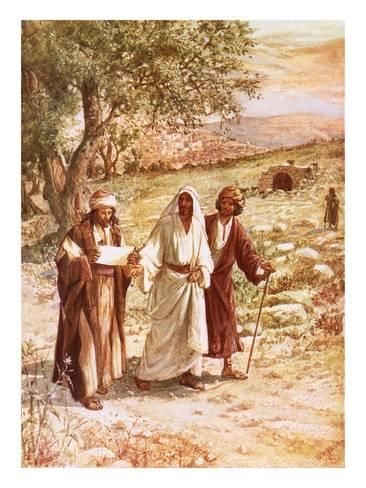
Luke tells us that on Sunday afternoon, two followers of Jesus were walking to a village called Emmaus, located 7 miles from Jerusalem. Some scholars believe the two followers were men. While one of the men was actually named by Luke, scholars cannot seem to agree on the second man’s name. Some have suggested it may have been Luke himself. But the correct answer is really right in front of our eyes if we bother to carefully read Scripture.
The Gospel of Luke tells us that one of the followers was named Cleopas who lived in the village of Emmaus (Luke 24:18). Cleopas is also thought to be known as Alphaeus and to have been the brother of Joseph the step father of Jesus. We then learn that Cleopas had a wife named Mary (John 19:25). Mary, as a married woman, would have been called Mary of Cleopas. Mary was also the sister of Mary wife of Joseph and the mother of Jesus. These two Mary’s are not to be confused with Mary who was from the city of Magdala. The name Mary is a derivative of the name Mariam the sister of Moses. So, the name Mary was as extremely popular in the first century as it still is today. Mary of Cleopas was the mother of James the Less or Younger one of the 12 disciples of Jesus. She was also the mother of Joses or Joseph also a follower of Jesus (Mark 15:40, Mark 16:1; Luke 24:10). Joseph was most probably named after his uncle the step father of Jesus. This means that the entire family were very close followers and staunch believers in Jesus. The Gospel of John tells us that all three Mary’s were at the cross during Jesus’ crucifixion. This means that Cleopas and his wife Mary were in Jerusalem during this time period. With this knowledge, the Emmaus storyline is now straightforward and obvious.
The couple was in Jerusalem to celebrate Passover with Jesus. The couple was asleep when Jesus was arrested and tried by the High Priest Caiaphas late Thursday night. But they were notified and probably in the crowd when Jesus was publicly tried by Pilate early Friday morning. Scripture tells us that Mary was at the cross during the crucifixion. Cleopas was also probably in the crucifixion crowd and perhaps assisted with Jesus’ burial. Scripture tells us that Mary, was there when Jesus’ body was prepared for burial and entombed. She was also there alone at the tomb with Mary Magdalene when the funeral wake left perhaps only an hour before Passover began at 6:00P.M. (Matthew 27:61).
The couple stayed in Jerusalem that Friday night to mourn with others the death of Jesus. They stayed in Jerusalem all day Saturday not only to continue mourning but because Passover happen to fall on a Saturday or Sabbath in April of 33A.D. There was a Jewish law that strictly forbid Jews to travel more than 3,281 feet on the Sabbath or during festivals. Passover ended Saturday at 6:00P.M. but they stayed in Jerusalem that night because Mary had made plans with several other women to visit Jesus’s tomb early Sunday morning. They wanted to put one last anointing of burial spices on Jesus’ corpse.
Sunday morning, Cleopas was with the disciples and other followers in a room when Mary Magdalene came running in with the news that Jesus’ body had been stolen. They listened to what she had to say but doubted that such a thing could be true. So, she left them and started walking back to the tomb. The women that she had originally accompanied to the tomb stayed at the site and actually went into the tomb. There they encountered two angels and received a message to take to the disciples. The women, which included Mary of Cleopas, started walking back to Jerusalem to give the message to the disciples that Jesus had arisen from His tomb and would meet them in Galilee (Matthew 28:1, 8-10). Just after they had left the tomb area, Mary Magdalene arrived back. But this time she also encountered the two angels that the women had talked with. The angels asked Mary why was she crying? It was then that she turned and saw Jesus. The two talked briefly and Jesus gave the same message to Mary that the angels had given to the women. Mary left the tomb and ran to relay the message to the disciples. Jesus then appeared and briefly spoke to the group of women who were now ahead of Mary and about to enter Jerusalem. He then ascended to heaven to meet with His Father. The group of women then continued into Jerusalem and met with the disciples. Shortly thereafter, Mary came into the room for a second time and told the disciples of her meeting with Jesus. It was then that Peter and John decided that, if the women’s stories were in fact true, then apparently Jesus was only meeting with followers at the tomb site. So, they decided to risk their lives and go the tomb in order to meet with Jesus. But when they arrived, they only found an empty tomb with the burial wrappings lying neatly on the body shelf. John immediately understood that Jesus had risen from the dead. But Peter was not sure what to think. They both returned to the meeting room filled with followers to plan their secret escape from Jerusalem and return home to the safety of the Galilee where they hoped to finally meet with Jesus.
Cleopas and Mary decided to wait with the disciples and other followers with the expectation that Jesus might arrive to talk with all of them. But by Sunday evening Jesus had not appeared, so Cleopas and Mary decided to walk 7 miles back to their home in Emmaus. They no doubt had planned to tell other followers in the village what she had heard and witnessed concerning Jesus’ resurrection and subsequence appearances.
So, according to all four Gospels, Jesus first met with Mary Magdalene and then the group of women who were returning to Jerusalem having left the tomb. He then ascended to His Father to consecrate the Everlasting Covenant. He then descended back to earth, and met with two followers walking back home to Emmaus. He stayed at their home for supper where He went from guest to host, blessed the food, revealed Himself to them and then disappeared. They immediately walked back to Jerusalem to tell the disciples what had happened. According to Luke and Paul, Jesus had a private meeting with Peter on Sunday. So, it must have been during this time period that this event took place (I Corinthians 15:5; Luke 24:34). Then Jesus descended down into Sheol to lead the righteous captive spirits into heaven (Ephesians 4:7-10; Psalm 68:18). Once the couple had entered the room and told their story, Jesus appeared to the disciples and other followers who were present.
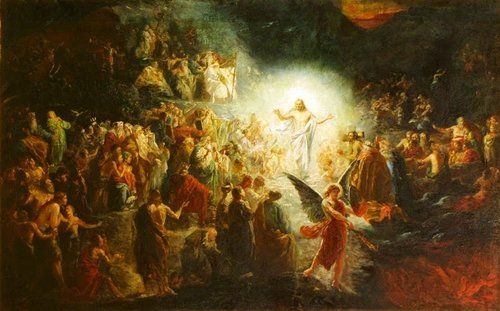
But why did it take so long for the couple to realize who Jesus was? First, Jesus had approached the couple from behind with His outer coat hood up over His head so they could not clearly see Him. Second, they did not stop walking to greet each other. Jesus simply drew near or caught up with them from behind and, looking forward, asked them what they were talking about thus, they did not clearly see Him face to face (Luke 24:15-16). They briefly stopped, their faces downcast, and asked Him if He really did not know the news about Jesus of Nazareth (Luke 24:17-18). They then told Him while walking, all that happened earlier that day and how startling the events were. Then, starting with the prophesies of Moses, Jesus explained to them how scripture was full of prophesies concerning the Messiah, His suffering, death and resurrection. Therefore, there was no excuse for them to be confused about the resurrection of the Messiah. This also means there is still no excuse for the Jews today to be confused about who Jesus was and is. Third, when they arrived at the fork in the road that led to the village of Emmaus, Jesus continued forward but stopped with His back to them when they called out and invited Him to supper (Luke24:28-29). Jesus agreed, turned and followed them into their home and sat quietly possibly with His hood still up. They went and quickly prepared a traditional small meal consisting of bread, fruit, salted fish and a cup of wine. When they brought the food to the table, Jesus still looking down, took the bread and for the first time looked up to heaven revealing His face. He then raised His arms revealing His crucifixion scars. He then repeated His traditional prayer that they had no doubt heard Him say many times before at the supper table. And as He turned, looked them in the eyes and gave them the bread to eat, they suddenly realized it was Jesus (Luke 24:30). Then, at that exact same moment, He vanished (Luke 24:31). It wasn’t as if Jesus so much vanished as it was He simple decided to leave the house. Jesus, in His resurrected body, was now capable of moving both slowly or at the speed of thought. And, a resurrected body is capable of passing through solid walls. This ability is scientifically known as quantum tunneling (Clara Moskowitz, “Particles Walk Through Walls While Physicists Watch” Wacky Physics, May 17, 2012).
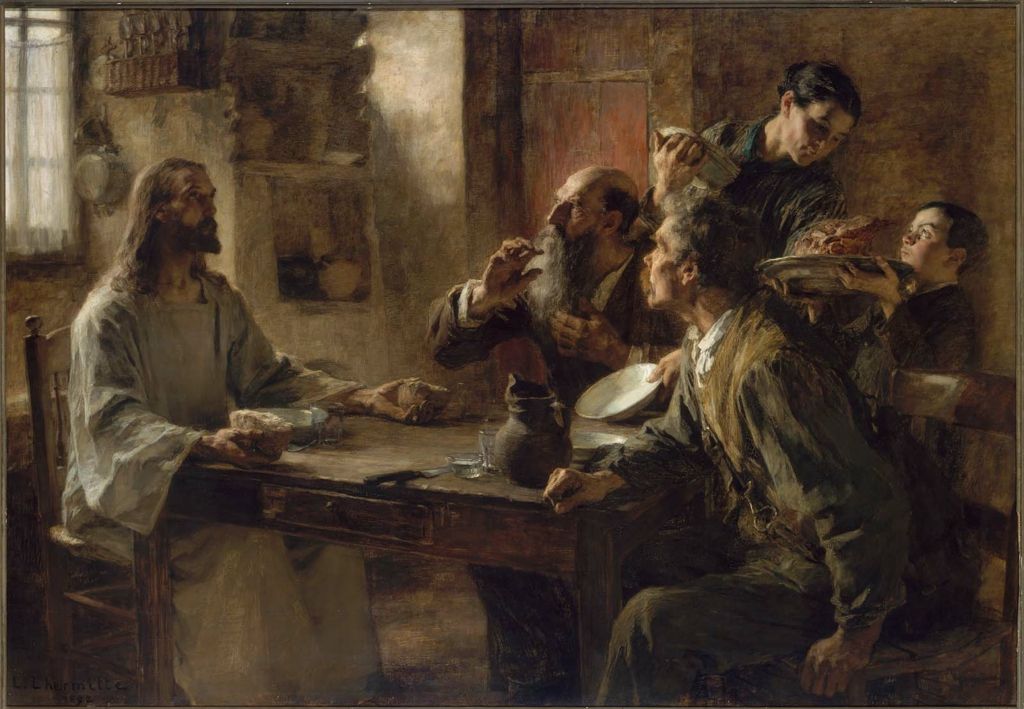
The couple immediately got up and walked back to Jerusalem to tell the followers what Jesus had said and done. The disciples still find it hard to believe both them, Mary Magdalene, and the other women (Mark 16:13). This was because the disciples could not fathom why Jesus, the man they had personally known and followed for the past 40 months, would arise from the dead and first meet with followers instead of them as his loyal disciples. But the reason seems to have been that, at this particular time, Jesus was only meeting with those who had faith in His resurrection. And it will be this same test of faith in order to participate in the rapture and to survive His appearance at the Second Coming. The disciples, at this time, were very skeptical about the women’s reports and this in turn showed a lack of faith on their part.
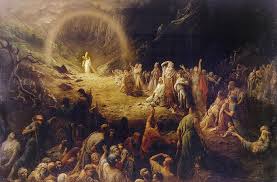
It was late Sunday evening but before His meeting with the disciples that Jesus bodily descended back down into Sheol for a second and final time. He did this in order to fulfill His promise to lead those righteous spirits held captive up and into the presence of God (Ephesians 4:8). He had spiritually gone down into Sheol the first time at His death on the cross. At that time, He preached the Gospel or good news to the spirits of the righteous dead (I Peter 3:19-20). This second descent then would qualify as the third night or Sunday evening that Jesus would be in the heart of the earth (Matthew 12:40). He was in the tomb Friday about 3:00 P.M. and all Friday night. He was in the tomb all day Saturday and Saturday night. And He was in the tomb Sunday just after sunrise. So that accounts for three days and two nights. His return to Sheol Sunday evening would make the third night He was in the heart of the earth as He had prophesied. It is now Sunday evening and all the disciples, except for Thomas, are together in a room. Luke tells us that there were others with the disciples at this time which would probably include the 3 Mary’s and Cleopas (Luke 24:33; Mark 16:14). The room’s door was closed and locked with the windows shuttered for security reasons. The group had gathered together for supper, a quiet worship service and to sort out the day’s extraordinary events.
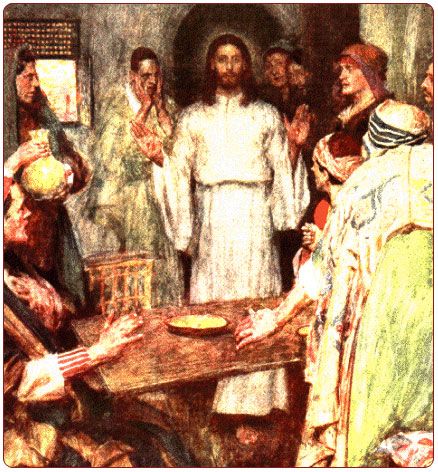
Suddenly, Jesus appeared, “… in the middle of them” (Luke 24:36). Jesus had passed through a wall of the room as easily as He had passed through His burial wrappings and the stone door used to seal His tomb. The door of the tomb was only removed by the angel so that the women could look inside. Jesus had passed through the tomb door at the break of dawn Sunday and was no doubt watching from a distance to see which of His followers had the faith and courage to come to the tomb that morning. When the group in the room suddenly noticed Jesus quietly standing among them, they all became “terrified” (Luke 24:37). They were sure they were seeing the ghost of a dead man. The women at the tomb had fallen at His feet and worshipped Him when they saw Him, but the disciples were terrified of Him! To be fair, at this time, people believed that to see a ghost or an angel was a premonition of one’s own impending death. Jesus immediately said, “Peace be with you. Why are you scared? Look at My hands and My feet and side” (Luke 24:39). “It is Me, touch Me, look at Me, I am not a ghost! I am flesh and bone”. Notice that Jesus does not say flesh and blood. This is probably because Jesus bled out on the cross. So, this remark may be a vailed understanding that blood will not be a part of the resurrected body. Instead, the resurrected body may run solely on the power of the Holy Spirit. Jesus then says, “Give Me some food to eat” (Luke 24:41). Jesus eats fish and honeycomb to prove He was not a ghost. He then revealed the Scripture to them concerning the Messiah just as He had done earlier with the couple on the road to Emmaus. He also told them He was disappointed that they did not believe that He would rise from the dead nor the multiple eyewitness reports from those who He had expressly sent to them concerning His resurrection (Mark 16:14).
Jesus would meet with them the following Sunday. Where and what He was doing that week is not known. Thomas had missed Jesus’ first appearance and was under the impression that the group must have experienced a mass hallucination (John 20:24-26). However, the following Sunday Jesus suddenly appears once again to the disciples including Thomas. Jesus again simply says “Hello!” to the gathering, then turns to Thomas and invites him to look and touch His crucifixion scars. Thomas immediately says to Jesus, “My Lord and My God,” which is the first time a disciple had uses a phrase this strong to identify Jesus as God (John 20:27).
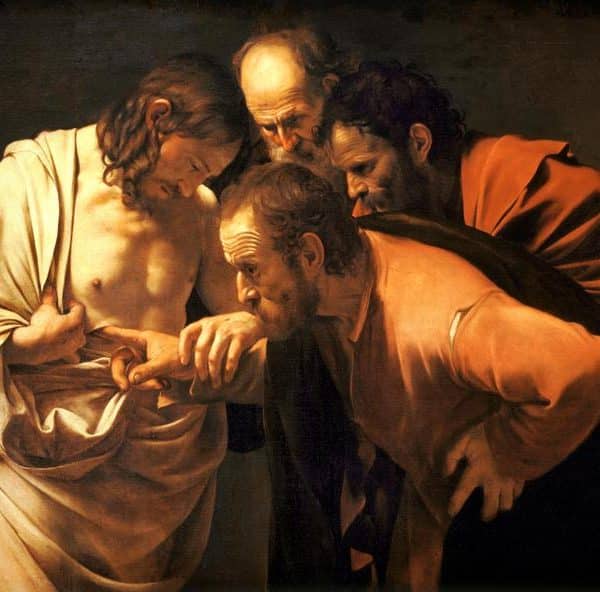
It should be noted that Jesus arose on a Sunday, His first of two meetings with his followers were on Sundays, He ascended on a Sunday, the Holy Spirit arrived on the day of Pentecost which was on a Sunday and the first day of creation was Sunday. And since Christians are no longer under the old Mosaic Covenant, but a new more perfect Everlasting Covenant sealed with the blood of Christ, it made more sense to worshiped on Sunday the day Jesus arose rather than continue the Jewish tradition of worshiping on Saturday (Exodus 20). In the creation story of Genesis, God rested on the 7th day from work and required the Jews under the Mosaic Covenant to also rest one day a week. The Jews chose to pray on the 7th day but that was not part of God’s requirement, only to rest. The Jews were always trying to create and follow laws and perform works that would earn them access to Heaven. These were only shadow efforts to be attempted until the Messiah would come and perform a final sacrifice on Passover that would allow all believers access into heaven through faith plus nothing else (Galatians 3:23-24; Colossians 2:16-17). Thus, the law is now dead and buried and a new age of grace and mercy is freely available. We are now under a new commandment initiated at the last supper by Jesus and consummated by His blood sacrifice on the cross.
Today, Muslims worship on Friday, Jews on Saturday and Christians have worshipped on Sunday since the end of the first century. Paul was asked if it was acceptable to worship on Sunday instead of Saturday. Paul said that Sunday was acceptable to God and added that Christians should worship God every day of the week (Romans 14:5). In short, God does not care when a person prays to Him as long as they pray. When we pray, we talk to God. When we study Scripture, God talks to us.
But what about the Roman guards who were also at the tomb and were eye witnesses to Jesus’ resurrection? Pilate was a Roman who prayed to a pantheon of Roman gods. His wife had told him of a dream she had concerning Jesus and that he should have nothing to do with Him (Matthew 27:19). This put the idea into Pilate’s mind that Jesus might well be the son of some god. Therefore, he did all he could to not be a part of Jesus’ trial (John 19:12). When the Jews told Pilate that Jesus called himself the “Son of God,” this scared him. He called Jesus back into his judgment hall and said to Him, “who are you?” Scripture seems to suggest that a number of Temple guards were also stationed at the tomb of Jesus. They were told of Jesus’ claim that He would rise from the dead. They no doubt passed this understanding on their Roman counterparts at the tomb. The Roman guards were superstitious as were all Romans. They had heard the story from the Centurion who witnessed Jesus command His own death while on the cross and then said out loud, “Surely He was the Son of God” (Matthew 27:54). Therefore, at this point, it would not take much to spook them, much less a man descending from the sky with flashes of lightening radiating out from his body. That sight had been enough to send most of the guards running. Still, some stood their ground and their reward was to experience a nervous breakdown leaving them in a semi-conscious stupor like walking dead men while others collapsed to the ground unconscious (Matthew 28:2-4).
A Roman guard understood that if he left his post for any reason, the punishment was death. Therefore, the soldiers that ran from the tomb decided not to report back to their commander but instead seek help from the Temple priests. They told the Chief Priests what they had seen at the tomb and were now afraid that they would be executed for desertion of their post. The Chief Priests met with the religious elders and not the Sanhedrin in order to quietly design a plan of action. They would need to explain away the facts that they had personally eye witnessed the death of Jesus and that the Romans execution squad had certified Him as dead yet His body was now missing. The Roman soldiers were given “large sums of money” and told to say that Jesus’ disciples came during the night while they were asleep and stole the body. They also told the soldiers that if their commander heard about them leaving their post, they would personally intervene on their behalf and do whatever it would take to keep them out of trouble. So, the solders took the hush money and did as they were instructed. And this is the story still believed by the Jews today (Matthew 28:11-15). However, there are several major flaws in this hastily concocted cover-up story.
A Roman Watch consist of 16 soldiers with four on active duty and a change of guards every four hours. So, all sixteen of the soldiers had to be asleep at the same time which is highly improbable. And, if all 16 were asleep, then which one saw the disciples remove the body? And, if the body was stolen, why were the body wrappings left in the tomb neatly folded (John 20:3-8)? And, if the disciples stole the body, why did the women and two disciples risk returning to the tomb Sunday morning with spices to pour on His remains. A first century chronicle states that Pilate did hear of the resurrection and sent an account of the event to Emperor Tiberius. Tiberius then requested that the Roman Senate pass a decree enrolling Jesus in the official pantheon of Roman gods. The first Christian historian Tertullian attests to this event (Tertullian, “Apologeticus”, (197 A.D.): pg. 5.1.2) as does Eusebius another early Christian historian (Eusebius, “Church History”, (323 A.D.): pg. 2.2.1-3). However, the Roman Senate ultimately rejected Emperor Tiberius’ proposal.
Jesus would meet regularly with His followers over the next 40 days (Acts 1:3). He also continued to preach and, at one of His sermons, there was over 500 people in attendance (I Corinthians.15:3-9). He appeared to His half-brother James sometime after He preached to the five hundred (I Corinthians 15:7). James was now convinced that Jesus was the resurrected Messiah and quickly succeeded Peter as the leader of the Church of Jerusalem. Jesus met with His disciples on a mountain top in Galilee some sixty miles north of Jerusalem. There, He talked with them and they shared a meal together (Matthew 28:16; Mark 16:14). Mark tells us that Jesus ascended some later time after He held this meeting with them (Mark 16:19). Jesus later appears to six of His disciples who were fishing in the Sea of Galilee and invited them to share a meal with Him. This meeting is very reminiscent of the first meeting Jesus had with Peter (John 21:9-14). It was at this time that Jesus asks Peter three times if he truly loved Him. There were two reasons for His questioning. The first concerned Peter denying Jesus three times during the night of His trial by the religious leaders. The second reason was that Christ wanted Peter to now commit himself to spreading the Gospel and not to fall back on his life as a fisherman. Peter as well as the other disciples needed to understand that their previous careers were now over. They would dedicate the rest of their lives and be martyred for preaching the good news of salvation thru Jesus the Christ.
The disciples had been with Jesus 24/7 for the past 40 months. They originally respected Him as their Rabbi but came to worship Him as the Messiah sent from God. He brought them a great sense of spiritual comfort and physical safety. But Jesus knew the time was fast approaching when He would be required to ascend back to the Godhead in order to send in His place what He called the “Helper”, Comforter or Holy Spirit (John 14:16, 26, John 16:8). Jesus was now immortal but He was still finite in a physical body. While He could go anywhere He wanted at the speed of thought, He was still only able to be in one place at any one time. He knew that the world-wide spreading of the Gospel would need to rely on the power of the Holy Spirit of God. It would be this power combined with His message that has caused His church movement to be the largest and fastest growing in the history of mankind. Today it is estimated that the Christian Church movement has an international membership of over 2.5 billion and continues to be the fast-growing church of any other religion. But it is also true that according to a recent report, the Christian Church is the most persecuted religion in the world (CATO Institution, “Christianity World’s Most Persecuted Religion” by Doug Bandon, March 7,2022).
Starting with His resurrection, Jesus began to slowly remove Himself from His disciples. He did this in order to give them time to adjust to His imminent physical absence from them. Forty days have now passed and it is ten days before the Feast of Pentecost. He takes His eleven disciples to a secluded place located on the far side of the Mount of Olives from Jerusalem near the village of Bethany (Luke 24:50). It was there that He told His disciples to wait in Jerusalem until the Holy Spirit of God, or what He termed a gift from His Father, would be sent to bring them comfort and power (John 14:15-17; Acts 1:4). It was then that He gave His disciples and all future followers what is referred to as the Great Commission. He commanded them to go throughout Jerusalem then Judea, Samaria, Israel and the world spreading the good news that salvation and eternal life was now possible through His death, burial and resurrection (Mark 16:15). He commanded them to do this because faith can only begin by first hearing. And hearing produces deliberation which leads to belief and ultimately faith. And it is faith that brings salvation and the reward of eternal life even after death. Having given them this last command, He bestowed a blessing on them. And, as He was blessing them, He began to slowly levitate up off the ground and into a cloud at which time He was hidden from sight and raptured into Heaven and back to the Throne of God (Luke 24:50-53; Acts 1:7-11). This means that His blessing for His believers never ended but continues to this day. This was the final physical miracle of Jesus’ ministry.
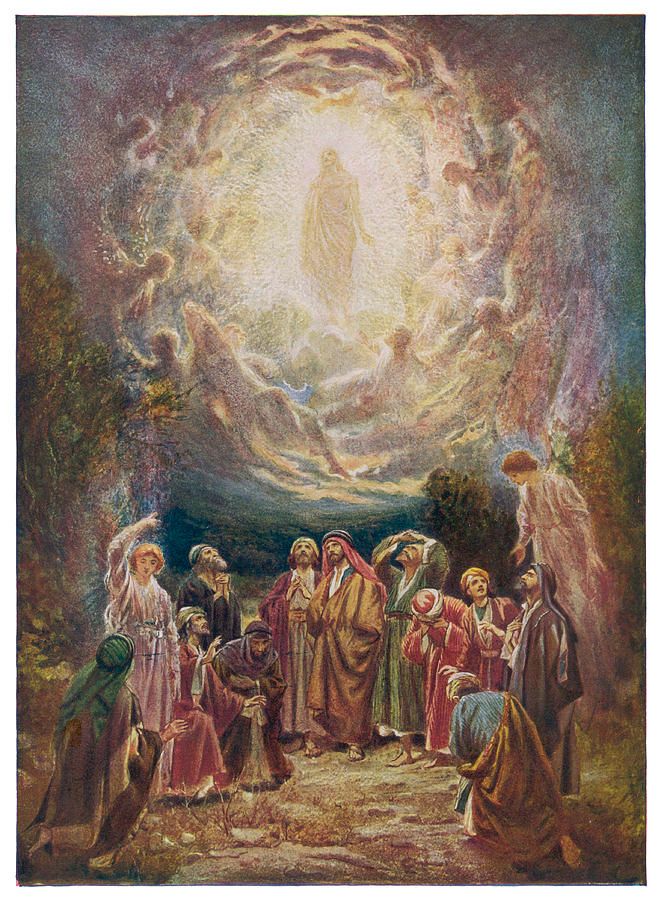
His inception had begun miraculously in a quiet forgotten village in the home of a peasant Jewish girl. His birth occurred on a dark, quiet spring night in a lowly stable having been rejected by the house of David. His short ministry of 40 months ended with Him on a lone hill top surrounded by His faithful eleven disciples. There He blessed and commissioned them now as Apostles to preach the good news to a fallen, weary world. And finally, in broad daylight for all to witness, He quietly and slowly ascended into heaven and back to God the Father.
The Feast of Pentecost was held to commemorate the giving of the Law from God through Moses to the people of Israel at Mount Sinai. When Moses came down from the mountain, he found the Jews worshiping a golden calf. Three thousand people who participated in the ritual were ordered to be killed (Exodus 32:25-29). This feast was always only a shadow of the actual event when the giving of the Holy Spirt from God through Jesus to the people of the world would take place. On the day of Pentecost 33 A.D., the apostles were gathered together on the southern steps of the Temple also known as the “House of God” (Acts 2:1-2). Suddenly, the noise of a rushing wind was heard and the Holy Spirit, appearing as a flame, descended on and permanently indwelled the apostles. They immediately began to preach the Gospel to the throngs of Jews coming up the massive steps to enter the Temple court. Only now each person, no matter their country of origin, heard the message of the apostles in their native tongue. In other words,10 people from 10 different countries all heard one apostle speak in a language they could all understand at the same time! This is not to be confused with speaking in tongues which is a spiritually inspired language that requires translation by a spiritually inspired translator (I Corinthians 14:4-6,9,13,16,19). This miracle performed by the apostles on Pentecost caused an instant response of excitement and belief in Jesus as the Messiah. Three thousand people were baptized in the purification pools located adjacent to the steps and received eternal life (Acts 2:41). Please see related: "The Miracle of Speaking in Tongues Revealed"
After Jesus had ascended from their sight, two angels who were perhaps the same two at His tomb, appeared among the apostles and asked them why they continued to stare up into the empty sky. At the tomb, they asked the women why they came seeking the living among the dead? They told the apostles that Jesus would return again to the same place in the same way they saw Him leave (Acts 1:10-11; Zechariah 13:6, 14:4). What the angels did not tell them was that Jesus would not return for the next 2,000 years in order to allow the New Covenant of grace and mercy with its new Church Age to bring salvation to many billions of people. And, unlike His first coming, His Second Coming would be seen simultaneously by the entire earth. And this time He would descend from the sky as a mighty warrior, the roaring Lion of Judah. He would be accompanied by an entourage composed of all His saints or believers along with an angelic army. And on that day, also known as the Day of the Lord, He would instantly destroy all the unrighteous of the world with only a word, take back possession of the earth He created and paid for with His life and establish a 1,000-year reign as King of kings and Lord of lords (Revelation 19: 7-9, 11-16, 19-20; Psalm 90:4; II Peter 3:8).
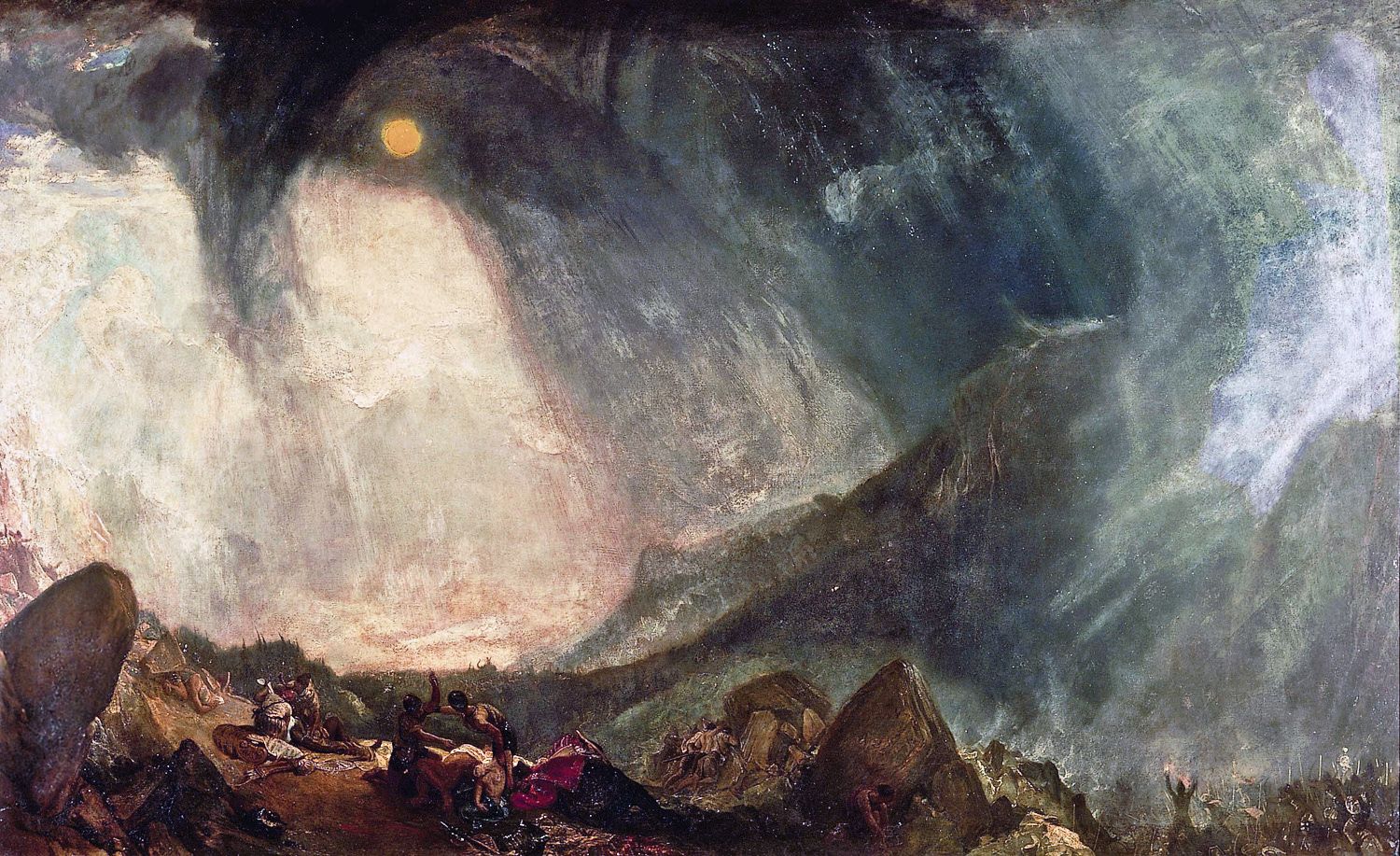
If you enjoy the information provided on this site, please consider making a donation of any amount to help continue its production. Donate Now

